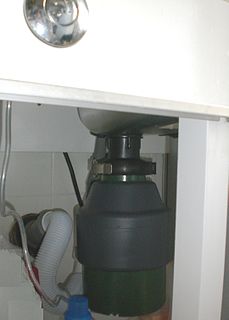
Garbage truck or dustcart refers to a truck specially designed to collect municipal solid waste and haul the collected waste to a solid waste treatment facility such as a landfill. Other common names for this type of truck include trash truck in the United States, and rubbish truck, junk truck, dumpster, bin wagon, dustbin lorry, bin lorry or bin van elsewhere. Technical names include waste collection vehicle and refuse collection vehicle. These trucks are a common sight in most urban areas.

A compactor is a machine or mechanism used to reduce the size of material such as waste material or bio mass through compaction. A trash compactor is often used by a home or business to reduce the volume of trash it produces. A baler-wrapper compactor is often used for making compact and wrapped bales in order to improve logistics.

Shelvoke and Drewry was a Letchworth, Hertfordshire manufacturer of special purpose commercial vehicles. It was best known for its innovative waste collection vehicles that were the preferred choice of municipal authorities in the UK together with their gully emptiers, cesspool cleaning vehicles and street watering and washing vehicles.
Saunders-Roe Limited, also known as Saro, was a British aero- and marine-engineering company based at Columbine Works, East Cowes, Isle of Wight.

Sterling Trucks Corporation is a former American truck manufacturer of Class 5-8 trucks. Taking on its name from a defunct American truck manufacturer, Sterling was formed in 1997 as Freightliner acquired the rights to the heavy-truck product lines of Ford Motor Company. Sterling-brand trucks were sold in the United States, Canada, Mexico, Australia, and New Zealand.
The Autocar Company is an American specialist manufacturer of severe-duty, Class 7 and Class 8 vocational trucks, based in Hagerstown, Indiana. Started in 1897 in Pittsburgh, Pennsylvania, as a manufacturer of Brass Era automobiles, and trucks from 1899, Autocar is the oldest surviving motor vehicle brand in the Western Hemisphere.

A garbage disposal unit is a device, usually electrically powered, installed under a kitchen sink between the sink's drain and the trap. The disposal unit shreds food waste into pieces small enough—generally less than 2 mm (0.079 in)—to pass through plumbing.
Dempster Brothers, Inc. of Knoxville, Tennessee, was an industrial firm that made waste handling vehicles including the Dempster Dumpmaster and Dempster Dinosaur. The firm was originally established by George Roby Dempster with his brothers Thomas and John Dempster.

An electric truck is an electric vehicle powered by batteries designed to deliver cargo.

Waste Management, Inc. is an American waste management, comprehensive waste, and environmental services company in North America. Founded in 1968, the company is headquartered in the First City Tower in Houston, Texas.
The Garwood Load Packer was a refuse collection vehicle built by Garwood Industries in Detroit, Michigan. Engineered by Melvin Donald Silvey, the Packer brought significant changes in the mode and automation of garbage collection in the United States.
Tadano Faun GmbH is a German manufacturer of mobile cranes based in the Franconian (Bavaria) town of Lauf an der Pegnitz. It is a 100% subsidiary company of the Japanese Tadano Limited. All Tadano all-terrain cranes are developed and produced in the plant in Lauf an der Pegnitz and then distributed across the globe by Tadano Faun GmbH’s global sales and service network.

A dumpster is a type of movable waste container designed to be brought and taken away by a special collection vehicle, or to a bin that a specially designed garbage truck lifts, empties into its hopper, and lowers, on the spot. The word is a generic trademark of Dumpster, an American brand name for a specific design. Generic usage of skip or skip bin is common in the UK and Australia, as Dumpster is neither an established nor well known brand in those countries.

Crane Carrier Company is a manufacturer that specializes in construction truck and garbage truck chassis. Located in Tulsa, Oklahoma, it was established by Robert Zeligson in 1946, along with the affiliated Zeligson Trucks. The primary design of CCC's trucks are Cab-Beside-Engine (CBE) or half-cabs, most notably the Century II Unimixer. Half-cabs have the advantage of being able to carry the booms of cranes, hence the name of the company.

McNeilus manufactures concrete transport trucks, and refuse collection vehicles in Dodge Center, Minnesota, where it is the largest employer.
Waste compaction is the process of compacting waste, reducing it in size. Garbage compactors and waste collection vehicles compress waste so that more of it can be stored in the same space. Waste is compacted again, more thoroughly, at the landfill to conserve valuable airspace and to extend the landfill's life span.

GAC Group is a Chinese automobile maker headquartered in Guangzhou, Guangdong, and a subsidiary of Guangzhou Automobile Industry Group.
KUKA Systems GmbH, a division of KUKA Aktiengesellschaft, Augsburg, is an international supplier of engineering services and flexible automated manufacturing solutions with around 3,900 employees in twelve countries globally.

Winters Brothers is a privately held waste disposal business in the Northeast United States. Its headquarters are in Westbury, New York; it currently serves the markets of New York and Connecticut, but previously also served Florida and Vermont. It sells its recovered products worldwide. It is the largest waste management firm in Long Island, and one of the largest in Connecticut. The firm has six recycling centers and twelve transfer stations.

Waste management in Taiwan refers to the management and disposal of waste in Taiwan. It is regulated by the Department of Waste Management of the Environmental Protection Administration of the Executive Yuan.















